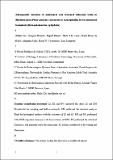Por favor, use este identificador para citar o enlazar a este item:
http://hdl.handle.net/10261/116366COMPARTIR / EXPORTAR:
 SHARE SHARE
 CORE
BASE CORE
BASE
|
|
| Visualizar otros formatos: MARC | Dublin Core | RDF | ORE | MODS | METS | DIDL | DATACITE | |

| Título: | Intraspecific variation of anatomical and chemical defensive traits in Maritime pine (Pinus pinaster) as factors in susceptibility to the pinewood nematode (Bursaphelenchus xylophilus) |
Autor: | Zas Arregui, Rafael CSIC ORCID; Moreira Tomé, Xoaquín CSIC ORCID; Ramos, Miguel; Lima, Marta R. M.; Nunes da Silva, Marta; Solla, Alejandro; Vasconcelos, Marta W.; Sampedro Pérez, Luis CSIC ORCID | Palabras clave: | Anatomical defences Nematode migration rate Non-volatile resin Pine wilt disease (PWD) Pine wilt disease (PWD) Population differentiation Resin canals |
Fecha de publicación: | jun-2015 | Editor: | Springer Nature | Citación: | Trees - Structure and Function 29 (3): 663-673 (2015) | Resumen: | The pinewood nematode or pine wilt nematode (PWN; Bursaphelenchus xylophilus) is one of the most dangerous threats to European coniferous forests, especially for the susceptible Maritime pine (Pinus pinaster), a valuable forest resource in South Western Europe. The PWN is vectored by beetles of the genus Monochamus (Coleoptera, Cerambycidae) and once inoculated in healthy branches, it quickly migrates downward to the main trunk through the resin canal system. Therefore, the anatomy of the resin canal system may modulate its migration and proliferation rates. Using material from nine Maritime pine Iberian provenances established in a common garden trial, we investigated whether these provenances differed in their (1) resin canal anatomy, (2) concentration of chemical defences (non-volatile resin and total polyphenolics) in stems and (3) ability of the PWN to migrate through the pine woody tissues in ‘in vitro’ bioassays. Whether variation in anatomical and chemical defensive traits relates to differences in PWN migration across populations was also investigated. Significant intraspecific variation in anatomical and chemical defensive traits and in nematode migration rates through pine tissues was observed. Moreover, the variation in nematode migration rate among pine provenances was related to differences in both anatomical and chemical features. Overall, this study highlights the role of plant genetics in the development of defensive traits against this harmful coniferous pest. The observed intraspecific variation should be taken into account when considering breeding as a strategy to provide areas of high risk of PWN with resistant genetic material. | Versión del editor: | http://dx.doi.org/ 10.1007/s00468-014-1143-6 | URI: | http://hdl.handle.net/10261/116366 | DOI: | 10.1007/s00468-014-1143-6 | ISSN: | 0931-1890 | E-ISSN: | 1432-2285 |
| Aparece en las colecciones: | (MBG) Artículos |
Ficheros en este ítem:
| Fichero | Descripción | Tamaño | Formato | |
|---|---|---|---|---|
| Zas_Intraspecific_variation...pdf | 329,33 kB | Adobe PDF |  Visualizar/Abrir |
CORE Recommender
SCOPUSTM
Citations
41
checked on 22-abr-2024
WEB OF SCIENCETM
Citations
40
checked on 24-feb-2024
Page view(s)
390
checked on 23-abr-2024
Download(s)
303
checked on 23-abr-2024
Google ScholarTM
Check
Altmetric
Altmetric
NOTA: Los ítems de Digital.CSIC están protegidos por copyright, con todos los derechos reservados, a menos que se indique lo contrario.
